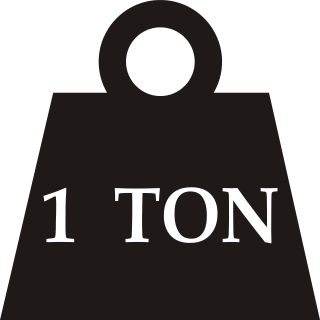Related Research Articles

Ton is any of several units of measure of mass, volume or force. It has a long history and has acquired several meanings and uses.

Tael, also known as the tahil and by other names, can refer to any one of several weight measures used in East Asia and Southeast Asia. It usually refers to the Chinese tael, a part of the Chinese system of weights and currency. The Chinese tael was standardized to 50 grams in 1959.

A bushel is an imperial and US customary unit of volume based upon an earlier measure of dry capacity. The old bushel is equal to 2 kennings (obsolete), 4 pecks, or 8 dry gallons, and was used mostly for agricultural products, such as wheat. In modern usage, the volume is nominal, with bushels denoting a mass defined differently for each commodity.
The catty, kati or 斤, pronounced as jīn in Mandarin and gan in Cantonese, is a traditional Chinese unit of mass used across East and Southeast Asia, notably for weighing food and other groceries. Related units include the picul, equal to 100 catties, and the tael, which is 1⁄16 of a catty. A stone is a former unit used in Hong Kong equal to 120 catties and a gwan (鈞) is 30 catties. Catty or kati is still used in Southeast Asia as a unit of measurement in some contexts especially by the significant Overseas Chinese populations across the region, particularly in Malaysia and Singapore.

A picul or tam is a traditional Asian unit of weight, defined as "as much as a man can carry on a shoulder-pole".
The quarter was used as the name of several distinct English units based on ¼ sizes of some base unit.
A number of different units of measurement were used in Argentina as its national system was derived from Spanish Castillian. The metric system was legally optional since 1863 and has been compulsory since 1887.
A number of different units of measurement were used in Chile to measure quantities like length, mass, area, capacity, etc. From 1848, the metric system has been compulsory in Chile.
A number of different units of measurement were historically used in Cyprus to measure quantities like length, mass, area and capacity. Before the Metric system, the Imperial system was used. In between 1986-1988, metric system was adopted in Cyprus.
A number of units of measurement were used in Egypt to measure length, mass, area, capacity, etc. In Egypt, the metric system was made optional in 1873 and has been compulsory in government use since 1891.
Traditional Greek units of measurement were standardized and used in modern Greece before and alongside the adoption of the metric system in 1836. Metric units were finally made legally compulsory in 1922.
A number of units of measurement were used in Guinea to measure length, mass, etc. Since 1910, the metric system has been compulsory in Guinea.
A number of units of measurement have been used in Cambodia to measure length, mass, volume, etc. The metric system has been compulsory there since 1914.
A number of units of measurement were used in Madagascar to measure length, mass, capacity, etc. The Metric system was introduced in Madagascar in 1897.
A number of units of measurement were used in Mexico to measure length, mass, area, capacity, etc. The Metric system was optional from 1857, and has been compulsory since 1896.
A number of units of measurement were used in Morocco to measure length, mass, capacity, etc. Metric system has been compulsory in Morocco since 1923.
A number of different units of measurement were used in Libya to measure length, mass, area, etc. The metric system was adopted in Libya in 1927.
A number of different units of measurement were used in Tunisia to measure length, mass, capacity, etc. In Tunisia, Metric System has been compulsory since 1895.
A number of units of measurement were used in South Africa to measure quantities like length, mass, capacity, etc. The Imperial system of measurements was made standard in 1922 and the metric system was adopted in 1961.
A number of units of measurement have been used in Tanzania to measure length, mass, capacity, etc. The metric system was adopted in Tanzania from 1967 to 1969.
References
- 1 2 3 Cardarelli, F. (2003). Encyclopaedia of Scientific Units, Weights and Measures. Their SI Equivalences and Origins. London: Springer. p. 151. ISBN 978-1-4471-1122-1.
- 1 2 3 4 5 6 7 8 9 10 11 12 13 Washburn, E.W. (1926). International Critical Tables of Numerical Data, Physics, Chemistry and Technology. New York: McGraw-Hil Book Company, Inc. pp. 5, 6. Retrieved 8 February 2015.
international critical hellotables 1926.
- 1 2 3 4 5 Clarke, F.W. (1891). Weights Measures and Money of All Nations. New York: D. Appleton & Company. p. 71.
- 1 2 Clarke, F.W. (1891). Weights Measures and Money of All Nations. New York: D. Appleton & Company. p. 49.
- 1 2 Clarke, F.W. (1891). Weights Measures and Money of All Nations. New York: D. Appleton & Company. p. 22.
- 1 2 3 Clarke, F.W. (1891). Weights Measures and Money of All Nations. New York: D. Appleton & Company. pp. 52–53.